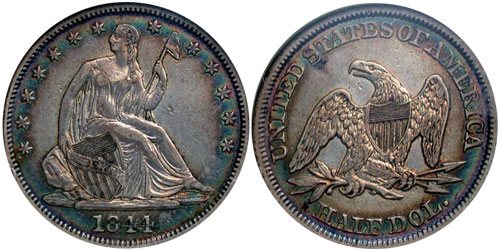Guide to U.S. Seated Liberty Half Dollars
The Seated Liberty Half Dollar was introduced in 1839 and would be minted until 1891. The same basic design had previously been adopted on the half dime in 1837 and the quarter in 1838. The design would also be used for the silver dollar starting in 1840. Similar to the other denominations, the half dollar would undergo a series of minor design and specification changes, resulting in the creation of different subtypes within the broader series. With production taking place over the course of more than five decades across four mint facilities, issues range from common to extremely rare with a number of intriguing varieties included.

Obverse Design
The Seated Liberty design was based on Britannia, who had been prominently featured on British coins. Artist Thomas Sully made a number of sketches, which United States Mint Assistant Engraver Christian Gobrecht adapted to be suitable for coinage. The obverse features an image of Liberty seated on a rock, facing left. One hand rests upon a shield with the inscription LIBERTY, while the other hand holds a pole with a cap atop. An arrangement of thirteen stars appears to the right and left, with the date below.
Reverse Design
The reverse design was similar to the one used for the prior Capped Bust series, with some small modifications to the size and visual appearance. An eagle appears at center with a shield at its breast and an olive branch and bundle of arrows grasped in its talons. The inscription UNITED STATES OF AMERICA appears above, with the denomination expressed as HALF DOL. below.
The first design change for the Liberty Seated Half Dollar occurred in the first year of issue for the series. As with other denominations that had adopted the motif, some minor modifications were still being made after the coins had been introduced. For the half dollar this was limited to the addition of drapery to Liberty’s dress near her elbow. This results in the 1839-dated coins being found either with “no drapery from elbow” or “drapery from elbow.”

A more significant change occurred as a result of the Mint Act of 1853, which lowered the weight and silver content of the denomination. To denote the coins struck with the new specifications, arrows were placed to each side of the date on the obverse and rays were added around the eagle on the reverse. The arrows and rays were used together for only a single year in 1853, creating a one-year subtype. For 1854 and 1855 the arrows appeared on the obverse with the standard reverse. From 1856 onwards, the arrows were removed, resuming the old design, but with the new specifications.

The next major change took place in 1866, one year after the end of the American Civil War. On the reverse, the motto IN GOD WE TRUST was placed on a scroll above the eagle’s head. Other denominations saw this addition as well. Eventually, legislation was passed to require the placement of this motto on every coin design where it could be accommodated.
From 1873 to 1874, arrows once again appeared next to the date on the obverse. This time the arrows were used to indicate a slight increase in weight. The arrows would be removed in 1875. From this point until the end of the series, the previous design was resumed with the new weight standard in place.

